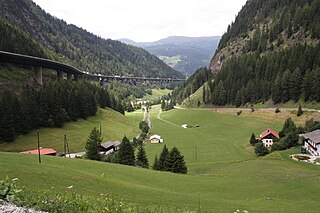
The Brenner Pass is a mountain pass over the Alps which forms the border between Italy and Austria. It is one of the principal passes of the Eastern Alpine range and has the lowest altitude among Alpine passes of the area.
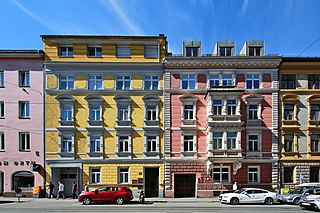
Innsbruck is the capital of Tyrol and the fifth-largest city in Austria. On the River Inn, at its junction with the Wipp Valley, which provides access to the Brenner Pass 30 km (19 mi) to the south, it had a population of 132,493 in 2018.

Tyrol is an Austrian federal state. It comprises the Austrian part of the historical Princely County of Tyrol. It is a constituent part of the present-day Euroregion Tyrol–South Tyrol–Trentino. The capital of Tyrol is Innsbruck.
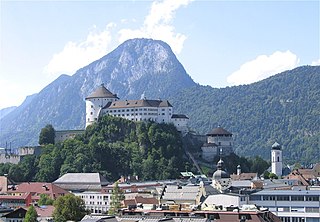
Kufstein is a town in the Austrian state of Tyrol, the administrative seat of Kufstein District. With a population of about 20,000 it is the second largest Tyrolean town after the state capital Innsbruck. The greatest landmark is Kufstein Fortress, first mentioned in the 13th century. The town was the place of origin of the Austrian noble family Kuefstein.

Landeck is a city in the Austrian state of Tyrol, the capital of the district of Landeck.
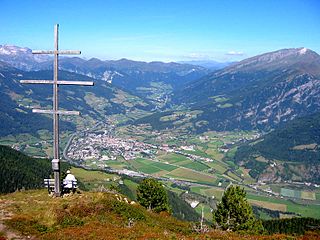
The Wipp Valley is an Alpine valley in Tyrol, Austria and in South Tyrol, Italy, running between Innsbruck and Franzensfeste. The Brenner Pass at the Austro-Italian border divides it into the northern, Austrian Lower Wipp Valley and the southern, Italian Upper Wipp Valley. The Lower Wipp Valley extends along the Sill River southward from Innsbruck, where the Sill meets the larger Inn River, up to the Brenner Pass. South of the border, the Upper Wipp Valley stretches along the Eisack River by way of Sterzing to Franzensfeste. It forms the Wipptal District of the province of South Tyrol.

Bundesautobahn 8 is an autobahn in southern Germany that runs 497 km (309 mi) from the Luxembourg A13 motorway at Schengen via Neunkirchen, Pirmasens, Karlsruhe, Pforzheim, Stuttgart, Ulm, Augsburg and Munich to the Austrian West Autobahn near Salzburg.

European route E45 connects Norway and Italy, through Finland, Sweden, Denmark, Germany and Austria. With a length of about 5,190 kilometres (3,225 mi), it is the longest north–south European route.

Gries am Brenner, often referred to as simply Gries, is a municipality in the Wipptal in the southern district of Innsbruck-Land. The village consists of several hamlets.

The Brenner Autobahn refers to a major European truck route that connects Innsbruck in Austria to Verona in northern Italy.

Innsbruck Hauptbahnhof is the main railway station in Innsbruck, the capital city of the Austrian federal state of Tyrol. Opened in 1853, the station is a major hub for western and central Austria. In 2019, it was the 8th-busiest station in the country, and the 2nd-busiest outside of Vienna after only Linz Hauptbahnhof, with 315 train movements and 38,500 passengers daily.

The Tyrol S-Bahn, operated by ÖBB, provides regional rail services in metropolitan Innsbruck, Austria and its hinterlands in the state of Tyrol; and extended rail services into Italy and Germany.

The Innsbruck bypass is a 14.853-kilometre (9.229 mi)-long double-track electrified main line of the Austrian railways. It connects the Lower Inn Valley railway with the Brenner railway, bypassing Innsbruck. It was opened on 29 May 1994. The line is at a major part of the rail freight network of Austrian Federal Railways (ÖBB).

The New Lower Inn Valley railway is a partially completed double-track high-speed main line of the Austrian railways. It connects the Brenner railway at Innsbruck and the Innsbruck bypass with the line to Kufstein, connecting with Germany, Salzburg, and eastern Austria. It forms a part of the core of the network of Austrian Federal Railways (ÖBB). The bypass is part of Line 1 of the Trans-European Transport Networks (TEN-T). The first section (Kundl–Baumkirchen), which is designed for speeds up to 220 km/h (140 mph), was opened on 26 November 2012. Since the timetable change on 9 December 2012, it relieves the existing Lower Inn Valley railway between Wörgl and Baumkirchen with trains able to operate at up to 250 km/h (160 mph). In the future, these and other construction projects are expected to reduce travel time on the Munich–Innsbruck route from 1:50 to 0:55 and on the Munich–Verona route from 5:20 to 2:20. The cost of the project amounted to €2.358 billion.

The Rosenheim–Kufstein railway is a 32 kilometre-long double-track main line of the German railways. It connects the Munich–Rosenheim and the Rosenheim–Salzburg lines at Rosenheim with the line to Innsbruck, thus connecting Germany, Salzburg and eastern Austria with Innsbruck and the Brenner line to Italy and the Arlberg line to far western Austria. The line is part of the Line 1 of Trans-European Transport Networks (TEN-T). It is electrified at 15 kV, 16.7 Hz.

The Deutsches Eck is the name given to the shortest and most convenient road and railway link between the Austrian metropolitan region of Salzburg and the Tyrolean Unterland with the state capital Innsbruck.

Tyrol is a historical region in the Alps of Northern Italy and western Austria. The area was historically the core of the County of Tyrol, part of the Holy Roman Empire, Austrian Empire and Austria-Hungary, from its formation in the 12th century until 1919. In 1919, following World War I and the dissolution of Austria-Hungary, it was divided into two modern administrative parts through the Treaty of Saint-Germain-en-Laye:
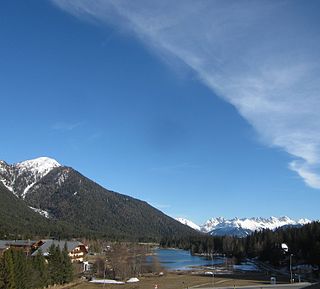
The Seefeld Saddle is a saddle and mountain pass, 1,185 m (AA), in the Northern Limestone Alps in the Austrian federal state of Tyrol. Two major transport routes run over it: the Seefelder Straße (B 177) and the Mittenwald Railway. On the Seefeld Plateau north of the saddle lies the village and ski resort of Seefeld in Tirol.

Eugen Schmidberger, Internationale Transporte und Planzüge v Austria (2003) C-112/00 is an EU law case, concerning the free movement of goods in the European Union.

The Arlberg Schnellstraße (S16) is an expressway (Schnellstraße) in Austria that is part of the E 60. It runs along a length of 62.2 km between Zams and Bludenz and connects the Inn Valley Autobahn (A12) in Tyrol with the Rheintal/Walgau Autobahn (A14) in Vorarlberg. The border between the two states is located in the Arlberg Tunnel (toll), which is 13,972 m long and is also the longest road tunnel in Austria. Overall, more than half of the route runs in long tunnels.





















